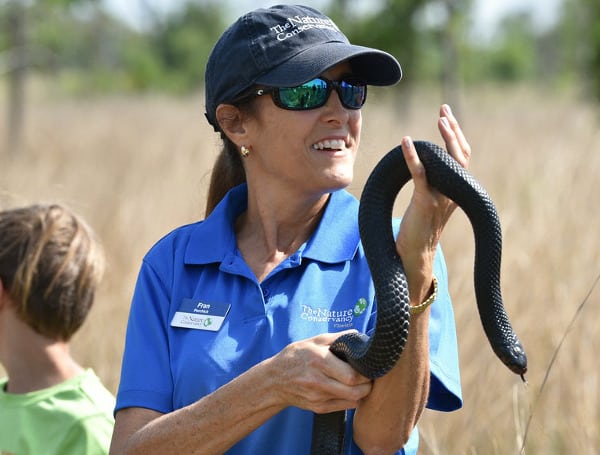The Florida Fish and Wildlife Conservation Commission (FWC) is sharing the annual reminder that many native wildlife species are more active during this time of year.
By becoming more aware of spring wildlife activity, Florida residents and visitors alike can help conserve our native species and reduce conflicts with them.
As spring brings warmer weather across the state, several species of wildlife become more active for migration, breeding, feeding and nesting.
This increased level of wildlife activity means that people could be more likely to encounter wildlife and should take precautions to avoid disrupting these natural behaviors and prevent conflicts with wildlife.
In the news: FWC Highlights Three Native Florida Snakes On World Snake Day
Tips on how to enjoy and help conserve Florida wildlife during spring:
Bats – Spring is when bats start to give birth and raise their young. Bat maternity season starts April 15 and runs through Aug. 15. During this time, it is illegal to block bats from their roosts. If bats are excluded during maternity season, flightless baby bats can be trapped inside the structure and die. Now is the time to do final spring checks of your home for any entry points, ensure that no bats are present and make any necessary repairs. If bats are found, you should take steps to properly install a bat exclusion device before bat maternity season begins. Exclusion devices, which allow bats to exit a structure but block them from returning to roosts, are the only legal and appropriate method to remove bats from your home or building.
Bears – As spring temperatures warm, bears become more active, increasing the opportunities for potential conflicts with people. During this time of year, females are teaching their cubs what to eat and the skills necessary to survive. Help make sure that eating garbage, pet food or bird seed in your yard is not part of that learning experience by removing attractants from your property. If bears can’t find food sources in your yard or neighborhood, they will move on.
In the news: Florida Fish And Wildlife Commission Seeks Input On Draft Revisions, Gopher Tortoise Permitting Guidelines
Gopher Tortoises – Spring days are a good time to spot a gopher tortoise, as Florida’s only native tortoise becomes more active, foraging for food and searching for a mate. If you see gopher tortoises or their half-moon shaped burrow entrances, it is best to leave them alone. You can help a gopher tortoise cross a road by picking it up and placing it in a safe location along the roadside in the direction it was heading. But only do this if it is safe for you to do so and remember the tortoise is a land animal, so never attempt to put it into water.
Injured and Orphaned Wildlife – If you find a baby animal, it is best to leave it alone. Young animals are rarely orphaned; a parent may be nearby searching for food. You can report common wildlife you think could be injured or orphaned to a licensed wildlife rehabilitator. For further guidance, you can contact the nearest FWC Regional Office.
In the news: Florida Wildlife Officials Approve Manatee Protections
Manatees – As manatees leave their winter habitats and travel the waterways along the Atlantic and Gulf coasts and other inland waters, chances of close encounters between manatees and boaters increase. Go slow and look out below for manatees when boating or using personal watercraft. For boaters and personal watercraft users, it is a critical time to be on the lookout for manatees to avoid collisions with these large aquatic mammals. Boaters should follow posted speed limits as many areas have seasonal zones in spring that reflect manatee migration patterns.
Nesting Waterbirds – Keep your distance from birds on the beach or on the water. If birds become agitated or leave their nests, you are too close. Disturbance can cause birds to abandon their nesting sites, which exposes their eggs and chicks to predators, sun exposure and other harm. Because shorebirds and seabirds build well-camouflaged shallow nests out of sand and shells on beaches, their nests, eggs and chicks are vulnerable to being stepped on unless people look out for them. Wading birds, such as herons and egrets, and pelicans also are nesting now on mangroves and tree islands
In the news: Nesting Season Arrives On Florida’s Coasts For Sea Turtles And Waterbirds
Sea Turtles – These large marine turtles start nesting on Florida beaches in spring. You can help by keeping beaches dark at night and free of obstacles during their March through October nesting season. Artificial lighting can disturb nesting sea turtles and disorient hatchlings, so avoid using flashlights or cellphones on the beach at night. Turn out lights or close curtains and shades in buildings along the beach after dark to ensure nesting turtles aren’t disturbed. Clear away boats and beach furniture at the end of the day and fill in holes in the sand that could entrap turtles.
Snakes – Keep an eye out for snakes in your yard or when hiking, as they could be encountered more as the weather warms. What should you do if you come upon a native snake? Just give them space. Snakes don’t purposefully position themselves to frighten people and usually try to avoid encounters.
Android Users, Click To Download The Free Press App And Never Miss A Story. Follow Us On Facebook and Twitter . Signup for our free newsletter . We can’t do this without your help; visit our GiveSendGo page and donate any dollar amount; every penny helps.




